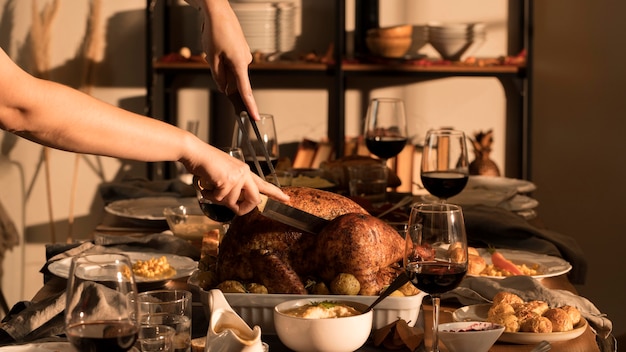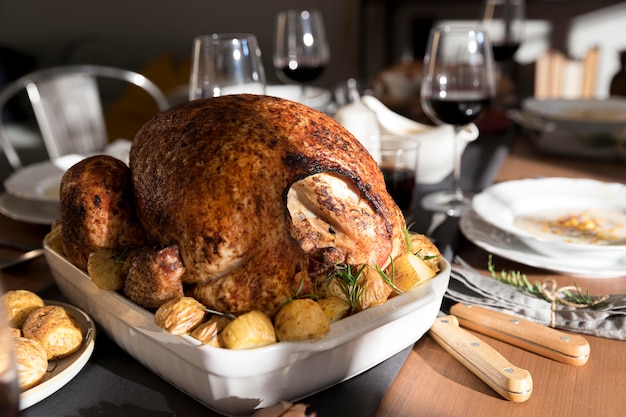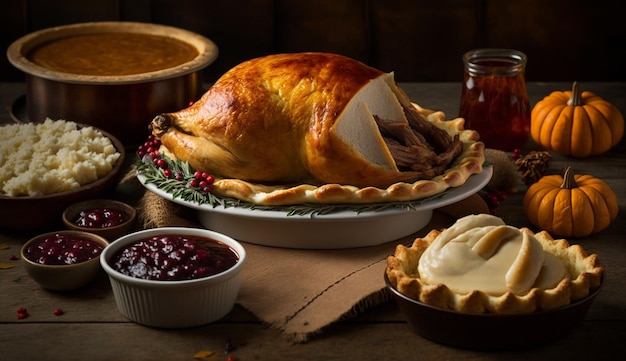You've got a 12lb turkey, the centerpiece of your festive feast, and you're wondering, "How long will this thing take to cook?". Well, fear not, my fellow culinary adventurer, you've come to the right place. I've spent years mastering the art of the roasted turkey, and I'm here to share my tried-and-true wisdom with you. Let's break down the process, step by step, and ensure a perfectly cooked, juicy, and flavorful turkey that will impress even the pickiest of eaters.
Part 1: The Turkey Timetable

Let's start with the basics. You'll often hear the rule of thumb: 15 minutes per pound of turkey. So, our 12lb turkey, theoretically, should take about 3 hours. But hold on, the turkey world isn't quite that simple.
Beyond the Basic Rule
That 15-minute rule is a good starting point, but it's just the beginning. The exact cooking time will depend on a few key factors, each of which we'll explore in detail.
The Turkey's Size and Shape
Imagine two turkeys, both weighing 12lbs. One is plump and round, while the other is more elongated, with a larger breast. The elongated turkey, with its thicker breast, will take a bit longer to cook evenly. The heat needs to penetrate deeper to ensure the entire breast reaches a safe internal temperature.
The Oven Temperature
Next, we have the oven temperature. Higher heat means faster cooking. For a 12lb turkey, I recommend roasting it at 350°F (175°C). But here's a little trick: You can start roasting at a higher temperature, like 400°F (200°C), for the first hour. This helps to get the skin beautifully crisp and golden. Then, reduce the temperature to 350°F (175°C) for the rest of the cooking time to ensure even cooking. It's all about achieving that perfect balance of crispy skin and juicy meat.
Stuffed or Unstuffed
Ah, the age-old debate: stuffed or unstuffed? Stuffing adds another layer of complexity to the cooking process. The stuffing needs to reach a safe internal temperature of 165°F (74°C), so you'll need to factor in some extra time. I usually add about 30 minutes to the cooking time for a stuffed turkey.
Part 2: The Temperature Check – Your Turkey's Lifeline

Now, let's talk about the most crucial element: checking the turkey's temperature. This isn't just a formality; it's your safety net, ensuring that the turkey is cooked through and safe to eat. It's where the trusty meat thermometer comes into play.
The Turkey's Internal Temperature - The Gold Standard
Your turkey is fully cooked when it reaches 165°F (74°C) in the thickest part of the thigh, making sure to avoid touching the bone. You can also check the temperature in the breast, which should also be 165°F (74°C).
Using the Meat Thermometer
Think of your meat thermometer as a trusted friend, guiding you to culinary success. Insert it into the thickest part of the thigh, making sure it doesn't touch the bone. Leave it there for a few seconds to get an accurate reading. You can also check the temperature in the breast.
Part 3: The Resting Time – The Secret to Juiciness

We've reached the finish line, the turkey is cooked, but don't rush to carve it just yet. Let that beautiful bird rest for at least 30 minutes. This seemingly simple step is crucial for unlocking maximum juiciness and flavor.
The Science Behind Resting
Resting allows the meat fibers to relax and the juices to redistribute throughout the turkey. If you carve it immediately, the juices will simply run out, leaving you with a dry, disappointing turkey. Be patient, my friend, the juicy reward awaits!
Part 4: The Roasting Process - Bringing Your Turkey to Life
Now, we're getting to the heart of the matter – the roasting process. This is where all your careful planning and preparations come together.
Preparing the Turkey – Setting the Stage for Success
First, pat the turkey dry with paper towels. This simple step ensures a crispy, golden-brown skin. Next, season it generously with salt, pepper, and herbs. I like to create a flavorful rub with olive oil, lemon juice, and my favorite herbs, rubbing it all over the turkey. It adds both moisture and a burst of flavor.
Roasting the Turkey – The Grand Finale
Place the turkey in a roasting pan and roast it in a preheated oven at 350°F (175°C) for about 15 minutes per pound. Remember, you can start at a higher temperature for the first hour to achieve that crispy skin. Don't forget to baste the turkey every 30 minutes or so with the pan juices. This helps to keep it moist and creates a beautiful, flavorful glaze.
Part 5: Turkey Cooking Time Variations – Adapting to Your Needs
Every turkey is unique, and sometimes, the standard rules need a little tweaking. Let's explore some common variations.
Smaller or Larger Turkeys
For a smaller turkey, like a 10lb bird, you'll need less time – about 2 hours and 30 minutes. A larger turkey, perhaps a 14lb behemoth, will require about 3 hours and 30 minutes. Adjust the cooking time based on the turkey's size.
Stuffed vs. Unstuffed
Remember that stuffed turkey? It needs about 30 minutes extra to ensure the stuffing reaches a safe internal temperature.
Oven Temperature Adjustment
If you decide to go with a higher oven temperature, you'll need to adjust the cooking time. A hotter oven means less cooking time. So, for example, if you choose 400°F (200°C), the turkey will cook faster than at 350°F (175°C).
Part 6: Dealing with a frozen turkey – Turning a Challenge into Triumph
So, you've got a frozen turkey and a deadline looming. Don't panic! You can definitely cook a frozen turkey, but you'll need to plan ahead and defrost it safely.
Defrosting a Frozen Turkey – The Key to Safe Eating
The safest way to defrost a turkey is in the refrigerator. Give yourself plenty of time – it takes about 24 hours to defrost a 12lb turkey in the refrigerator. You can also defrost it in cold water, but it will take about 3 to 5 hours. Never defrost a turkey at room temperature, as it can encourage bacteria growth and make it unsafe to eat.
Using a Frozen Turkey – A Little Extra Time
If you're short on time and the turkey is still frozen, you can roast it from frozen. However, you'll need to add about 50% more time to the cooking time. And remember, the turkey must reach an internal temperature of 165°F (74°C) to ensure it's safe to eat.
Part 7: Turkey cooking tips and Tricks – The Secrets of the Pros
Now, let's dive into some pro-level tips and tricks to take your turkey roasting to the next level.
Brining the Turkey – Unlocking Ultimate Juiciness
Brining is a game-changer, folks. It involves soaking the turkey in a salt water solution for a few hours or overnight. The salt helps to retain moisture in the meat, resulting in a juicy, tender turkey. You can use a simple brine with salt and water, or get fancy with herbs and spices for added flavor.
Using a Roasting Rack – Ensuring Even Cooking
A roasting rack is your best friend for even cooking and crispy skin. It elevates the turkey, allowing hot air to circulate all around it. This ensures that the heat reaches every part of the turkey evenly.
Basting the Turkey – Keeping it Moist and Delicious
Basting is a labor of love. It involves pouring the pan juices over the turkey, keeping it moist and creating a flavorful glaze. Baste every 30 minutes or so, using the pan juices or a mixture of butter, herbs, and spices for extra flavor.
Using a turkey thermometer – Your Culinary Compass
I've already mentioned this, but it bears repeating: a turkey thermometer is your culinary compass, guiding you to perfection. It's the only way to know for sure if the turkey is cooked through and safe to eat.
Resting the Turkey – The Final Touch for Juicy Perfection
After all that hard work, let the turkey rest for at least 30 minutes before carving. This allows the juices to redistribute, ensuring a juicy, flavorful turkey that will make everyone at the table happy.
Part 8: turkey leftovers – Turning Leftovers into Culinary Gold
Now, you've got a delicious roasted turkey, and chances are, you'll have leftovers. But don't see leftovers as a waste; they're an opportunity for creativity and deliciousness!
Storing Turkey Leftovers – Keeping it Fresh and Safe
Store turkey leftovers in the refrigerator for up to 3 to 4 days. Refrigerate them promptly to prevent bacteria growth.
Reheating Turkey Leftovers – Making it Delicious Again
You can reheat turkey leftovers in the oven, microwave, or on the stovetop. Just make sure the turkey reaches an internal temperature of 165°F (74°C) to ensure it's safe to eat.
Creative Turkey leftover recipes – Turning Leftovers into Meals
Turkey leftovers are versatile. Use them to make sandwiches, salads, soups, casseroles, and more. Let your culinary imagination run wild!
Part 9: Common turkey cooking mistakes – Avoiding the Pitfalls
You're almost there, turkey in the oven, a sense of accomplishment in the air. But be warned, there are some common mistakes that can sabotage your turkey roasting efforts. Let's avoid those!
Overcrowding the Oven – Giving the Turkey Space to Breathe
Don't cram the oven with too many dishes. If you're roasting the turkey alongside other dishes, make sure there's enough space for the hot air to circulate around the turkey. This helps ensure even cooking.
Not Using a Meat Thermometer – Trusting the Thermometer
Don't rely solely on appearance. A meat thermometer is the only reliable way to know for sure if the turkey is cooked through.
Carving the Turkey Too Soon – The Patience of a Chef
Resist the urge to carve the turkey immediately. Let it rest for at least 30 minutes. This is essential for juicy, flavorful results.
Not Basting the Turkey – Adding Moisture and Flavor
Don't forget to baste that turkey! Basting every 30 minutes keeps it moist and flavorful.
Part 10: FAQs – Addressing Your Questions
Alright, let's address some frequently asked questions about turkey cooking.
1. How long does it take to roast a 12lb turkey at 325°F?
A 12lb turkey will take about 3 hours to cook at 325°F (165°C). But remember, it's always best to check the internal temperature to ensure it's fully cooked.
2. Can I roast a turkey from frozen?
Yes, you can roast a turkey from frozen, but you'll need to add about 50% more time to the cooking time. And again, make sure it reaches an internal temperature of 165°F (74°C).
3. What's the best way to keep a turkey moist?
Brining is a great way to keep a turkey moist, but a roasting rack, basting, and resting the turkey also contribute to a juicy bird.
4. How do I know when a turkey is done?
The turkey is done when the internal temperature reaches 165°F (74°C) in the thickest part of the thigh, without touching the bone. You can also check the temperature in the breast, which should also be 165°F (74°C).
5. What should I do with leftover turkey?
Turkey leftovers are a culinary goldmine. Use them to make sandwiches, salads, soups, casseroles, and more. Get creative and experiment with different recipes!
And there you have it, my friends. You're now equipped with the knowledge to roast a delicious 12lb turkey. Happy roasting, and remember, it's all about the journey. So relax, have fun, and enjoy the festive feast!
Now, go forth and conquer the turkey!
Everyone is watching

Corn on the Cob: The Ultimate Guide to Perfectly Cooked Ears
Healthy MealsAh, corn on the cob. Just the name evokes images of sunny days, barbecues, and that sweet, juicy flavour that ...

Perfect Pork Roast Oven Cooking Time: A Guide to Delicious Results
Healthy MealsThere's something truly satisfying about a perfectly roasted pork. The aroma alone is enough to make your mout...

Ham Cooking Time: How Long to Bake, Smoke, or Boil a Delicious Ham
Healthy MealsAh, ham. It's a classic, isn't it? A real crowd-pleaser, especially around holidays. And when done right, it'...

Scallops: The Ultimate Guide to Perfect Cooking
Healthy MealsAh, scallops. Those delicate, sweet, and utterly delicious morsels of the sea. They hold a special place in my...

Spaghetti Squash: The Ultimate Guide to Cooking and Serving
Healthy MealsRemember that time you saw spaghetti squash at the supermarket, looking all bumpy and strange, and thought, "W...
